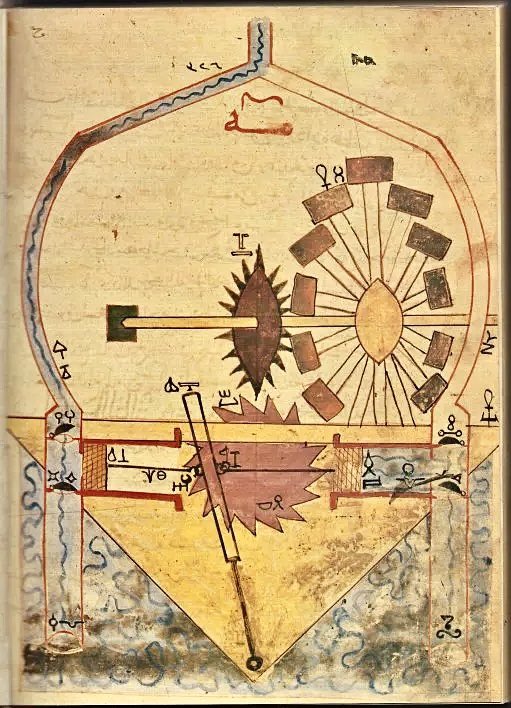Ever wondered who invented robotics?
Ismail al-Jazari, a Muslim inventor from the 12th century is known as the "father of robotics" due to his groundbreaking work in the field of automata, which are self-operating machines.
A thread on Ismail al-Jazari, engineering & robotics…
Ismail al-Jazari, a Muslim inventor from the 12th century is known as the "father of robotics" due to his groundbreaking work in the field of automata, which are self-operating machines.
A thread on Ismail al-Jazari, engineering & robotics…

1/ While robotics is considered a relatively new field of science, with the public’s consensus that it is the creation of 20th-century scientists, it would be surprising to know that the field has its roots in the medieval era nearly a millennium ago, with Ismail Al Jazari 

2/ Ismail Al Jazari gained fame for his extraordinary inventions, encompassing a wide spectrum of marvels. His repertoire included robots programmed to provide guests with towels, programmable on-off switches for fountains, automated mechanical clocks & much more!
A Candle Clock… twitter.com/i/web/status/1…
A Candle Clock… twitter.com/i/web/status/1…

3/ Al-Jazari's "peacock fountain" was a sophisticated hand washing device featuring humanoid automata which offer soap and towels. 

4/ While some of his elaborate & vivid devices were designed as luxurious playthings for the wealthy, Al-Jazari also developed practical machines that greatly benefited ordinary people, such as water-drawing contraptions that farmers relied on for centuries
Al-Jazari’s water… twitter.com/i/web/status/1…
Al-Jazari’s water… twitter.com/i/web/status/1…

5/ Al-Jazari, whose full name was Badi' al-Zaman Abu al-'Izz Isma'il ibn al-Razzaz al-Jazari, was born in 1136 in the region of Mesopotamia, which is present-day Iraq. He was employed as a chief engineer at the Artuqid palace in Diyarbakır, modern-day Turkey. 

6/ After an impressive 25-year period of innovation, Al-Jazari compiled a catalog of his inventions in 1206, considered one of the most important mechanical engineering texts of the medieval Islamic world. 

7/ This comprehensive collection, known as "The Book of Knowledge of Ingenious Mechanical Devices" (Arabic: Kitab fi ma'rifat al-hiyal al-handasiyya), provides detailed diagrams and vibrant illustrations that showcase the inner workings of his creations.
Water-powered mechanism… twitter.com/i/web/status/1…
Water-powered mechanism… twitter.com/i/web/status/1…

8/ The book describes over 50 mechanical devices, including automata, water clocks, fountains, musical instruments, and various mechanical contraptions.
A drawing of the driver from the elephant clock reveals how the arms should be attached.
A drawing of the driver from the elephant clock reveals how the arms should be attached.

9/ Although some parts of the book are missing, multiple surviving copies exist, including one housed in the Topkapi Sarayi Museum in Istanbul, Turkey. This particular edition is renowned for its captivating artistic detail and aesthetic allure.
Design on Each Side for… twitter.com/i/web/status/1…
Design on Each Side for… twitter.com/i/web/status/1…

10/ Al-Jazari's inventions were not merely functional but often showcased intricate designs and artistic elements. He combined engineering with aesthetics, creating visually appealing machines.
The Beaker Water Clock
The Beaker Water Clock

11/ One of his notable inventions was the "Elephant Clock." This clock featured a mechanical elephant with a mahout on top. The elephant made movements, and different parts of the clock indicated the time, including a swinging pendulum and rotating balls. 

12/ One of Al-Jazari's remarkable inventions holds significant importance for historians of science, as it is widely considered to be the earliest programmable "robot" in history... 

13/ Resembling a music box in function, this invention took the form of a boat adorned with four "musicians" – a harpist, a flautist, & 2 drummers – performing songs for entertainment. The intriguing aspect lies in the programmability of the drummers' mechanisms, creating rhythms 

14/ One of Al Jazari’s well-known inventions was the first ever four-dial combination lock for a chest or casket. Only five caskets from the early 13th century with such a four-dial combination lock on the lid are known to still exist.
Combination lock box in @KhaliliOnline
Combination lock box in @KhaliliOnline

16/ An illustration from Al-Jazari’s The book of Knowledge of ingenious Mechanical Devices depicts a robot that serves drinks.
The writing at the right describes how the device works.
The writing at the right describes how the device works.

17/ Al-Jazari's inventions were not limited to clocks and automata. He also designed various ingenious water-raising machines, water pumps, and hydraulic systems.
The inner workings of a water-drawing machine show how hidden gears drive an animated cow around a vertical shaft,… twitter.com/i/web/status/1…
The inner workings of a water-drawing machine show how hidden gears drive an animated cow around a vertical shaft,… twitter.com/i/web/status/1…

18/ His water-raising machines included the "Saqiya" and the "Archimedean Screw," both of which were used to lift water for irrigation purposes. 

19/ Al-Jazari's work influenced subsequent generations of engineers and inventors, and his designs were replicated and improved upon in later centuries.
The Castle Water Clock
The Castle Water Clock

20/ He played a crucial role in advancing the field of robotics, particularly in the development of programmable automata. His inventions laid the foundation for modern mechanical engineering and automation.
Figure for Use at Drinking Parties
Figure for Use at Drinking Parties

21/ Al-Jazari's work was not widely known in the Western world until the 19th century when his manuscripts were translated into European languages.
Mechanical Device for Display at a Drinking Party
Mechanical Device for Display at a Drinking Party

22/ His contributions to the field of engineering and automation were recognized and celebrated globally. In 2016, the United Nations Educational, Scientific and Cultural Organization (UNESCO) included Al-Jazari in its "Global Treasures" series, honoring his legacy.
The… twitter.com/i/web/status/1…
The… twitter.com/i/web/status/1…

23/ Al-Jazari's innovative and imaginative approach to engineering paved the way for future advancements in robotics, automation, and mechanical engineering.
Automata by Al Jazari
Automata by Al Jazari

24/ Today, Al-Jazari's legacy lives on, and his work continues to inspire and inform researchers, engineers, and inventors in the field of robotics and automation. 

• • •
Missing some Tweet in this thread? You can try to
force a refresh























